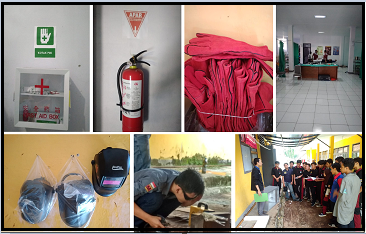Main Article Content
Abstract
Occupational Health and Safety (OSH) in the industry and vocational education institutions are very important elements to ensure user safety and keep the machines in good condition. Polytechnics must be able to prepare OSH standards in the practical learning process in the laboratory. Therefore, this study aims to evaluate the compliance of the Subang State Polytechnic Laboratory in the application of OSH. Observation data obtained were analyzed by descriptively – quantitatively methods. The results showed that the facilities and application of OSH at the Subang State Polytechnic laboratory received a score of 67.20 so that it was in the feasible category.
Article Details
References
- H. Sofyan and A. Efendi, “Implementation of Teacherpreneurship on Teachers at Vocational High School,” in Proceedings of the International Conference on Technology and Vocational Teachers (ICTVT 2017), 2017, vol. 102, pp. 229–236.
- D. Nurhadi and N. Lyau, “Cultivating Responsibilities of Vocational Teachers: A Framework for Preparing Education to Work,” Jurnal Pendidikan Teknologi dan Kejuruan, vol. 24, no. 2, pp. 295–302, 2018.
- W. Noviansyah and A. Efendi, “Analisis Kesiapan dan Hambatan Partnership Mak-Dudi di Daerah Istimewa Yogyakarta,” in Seminar Nasional dan Pameran Produk Pendidikan Vokasi ke 1, 2016, pp. 124–129.
- N. Hidayat and I. Wahyuni, “Kajian Keselamatan dan Kesehatan Kerja Bengkel di Jurusan Pendidikan Teknik Sipil dan Perencanaan Fakultas Teknik UNY,” Jurnal Pendidikan Teknologi Kejuruan, vol. 23, no. 1, pp. 51–66, 2016.
- K. Yu, L. Zhou, C. Hu, L. Wang, and W. Jin, “Analysis of Influencing Factors of Occupational Safety and Health in Coal Chemical Enterprises Based on the Analytic Network Process and System Dynamics,” Processes, vol. 7, no. 1, p. 53, 2019.
- B. M. Zimolong and G. Elke, “Occupational Health and Safety Management,” Handbook of Human Factors and Ergonomics, pp. 671–707, 2006.
- W. Y. Christina, L. Djakfar, and A. Thoyib, “Pengaruh Budaya Keselamatan dan Kesehatan Kerja (K3) Terhadap Kinerja Proyek Konstruksi,” Rekayasa Sipil, vol. 6, no. 1, pp. 83–95, 2012.
- Iman Kurniawan Wicaksono, “Manajemen Risisko K3 (Keselamatan dan Kesehatan Kerja),” ITS, 2011.
- R. D. Wirahadikusumah, “Tantangan Masalah Keselamatan dan Kesehatan Kerja pada Proyek Konstruksi di Indonesia,” Bandung, 2006.
- P. Hargiyarto, “Analisis kondisi dan pengendalian bahaya di bengkel/ laboratorium sekolah menengah kejuruan,” pp. 203–210, 2010.
- D. Komarudin, W. S. Kuswana, and R. A. M. Noor, “Kesehatan dan Keselamatan Kerja di SMK,” Journal of Mechanical Engineering Education, vol. 3, no. 1, pp. 46–51, 2016.
- H. Nasrullah, “Pembuatan dan Pengujian Media Pembelajaran K3 (Keselamatan dan Kesehatan Kerja) Berbasis Android,” Automotive Experiences, vol. 1, no. 02, pp. 53–57, 2018.
- D. Zhao and J. Lucas, “Virtual reality simulation for construction safety promotion,” International Journal of Injury Control and Safety Promotion, vol. 22, no. 1, pp. 57–67, 2015.
- A. Cohen and M. J. Colligan, “Assessing Occupational Safety and Health Training,” DHHS (NIOSH) Publication, no. June, pp. 98–145, 1998.

